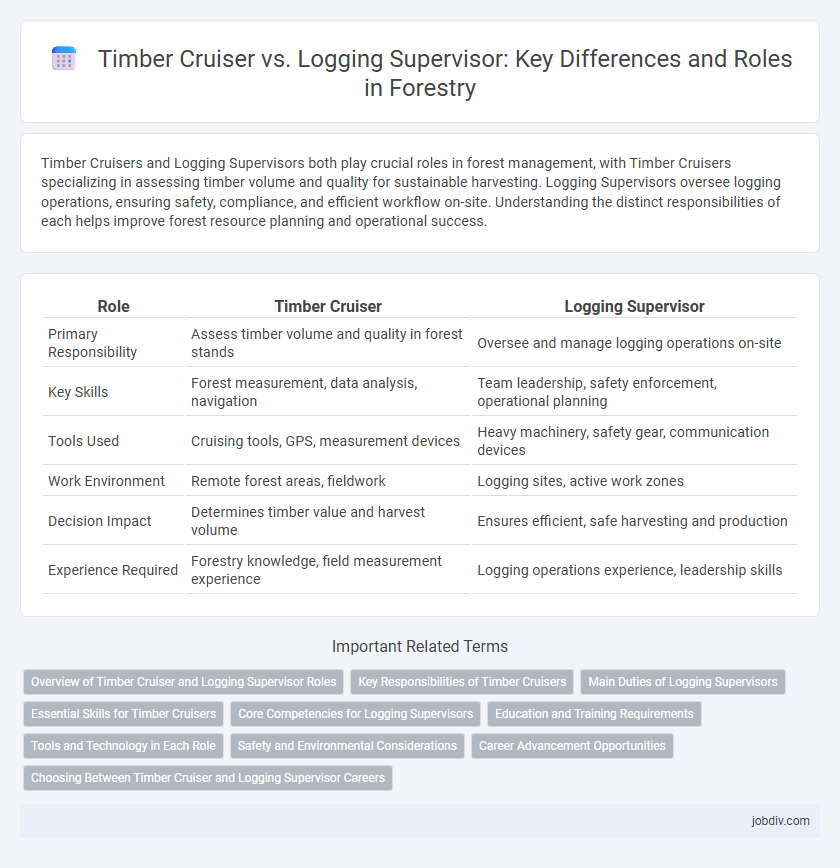Timber Cruisers and Logging Supervisors both play crucial roles in forest management, with Timber Cruisers specializing in assessing timber volume and quality for sustainable harvesting. Logging Supervisors oversee logging operations, ensuring safety, compliance, and efficient workflow on-site. Understanding the distinct responsibilities of each helps improve forest resource planning and operational success.
Table of Comparison
| Role | Timber Cruiser | Logging Supervisor |
|---|---|---|
| Primary Responsibility | Assess timber volume and quality in forest stands | Oversee and manage logging operations on-site |
| Key Skills | Forest measurement, data analysis, navigation | Team leadership, safety enforcement, operational planning |
| Tools Used | Cruising tools, GPS, measurement devices | Heavy machinery, safety gear, communication devices |
| Work Environment | Remote forest areas, fieldwork | Logging sites, active work zones |
| Decision Impact | Determines timber value and harvest volume | Ensures efficient, safe harvesting and production |
| Experience Required | Forestry knowledge, field measurement experience | Logging operations experience, leadership skills |
Overview of Timber Cruiser and Logging Supervisor Roles
Timber Cruisers specialize in assessing forest stands by measuring tree volume, quality, and growth to estimate timber resources accurately. Logging Supervisors manage daily logging operations, ensuring safety protocols, equipment efficiency, and adherence to harvesting plans. Both roles are critical in sustainable forest management, supporting inventory evaluation and operational execution.
Key Responsibilities of Timber Cruisers
Timber cruisers are responsible for estimating the volume, quality, and value of timber through detailed field measurements and data collection, essential for effective forest management and inventory assessment. They use tools such as diameter tapes, clinometers, and increment borers to gather accurate tree data, which informs logging schedules and sustainable harvesting plans. Their reports guide logging supervisors in operational decisions, ensuring compliance with environmental regulations and maximizing resource efficiency.
Main Duties of Logging Supervisors
Logging supervisors oversee timber harvesting operations, ensuring compliance with safety regulations and environmental standards while coordinating crews and machinery to optimize productivity. They manage site logistics, monitor timber quality, and enforce sustainable forestry practices to meet project goals. Their role involves detailed planning and real-time problem solving to maintain efficient and safe logging activities.
Essential Skills for Timber Cruisers
Timber cruisers require essential skills such as precise tree measurement, species identification, and effective use of GPS and mapping technology to assess forest stands accurately. Proficiency in data collection and interpretation supports timber volume estimation and forest management decisions. Strong communication skills enable timber cruisers to relay critical information efficiently to logging supervisors, ensuring sustainable and efficient harvesting operations.
Core Competencies for Logging Supervisors
Logging Supervisors require advanced core competencies including expertise in forest management, safety regulations, and crew leadership to oversee timber harvesting operations effectively. Unlike Timber Cruisers, who focus primarily on inventory assessment and timber valuation, Logging Supervisors coordinate logistics, enforce environmental compliance, and manage workforce productivity. Strong communication skills, knowledge of sustainable harvesting techniques, and proficiency in equipment operation are essential to optimize operational efficiency and minimize ecological impact.
Education and Training Requirements
Timber Cruisers typically require a bachelor's degree in forestry, natural resources, or a related field, emphasizing skills in tree measurement, sample plot data collection, and forest inventory techniques. Logging Supervisors often have a high school diploma or associate degree supplemented by extensive hands-on experience in logging operations, safety regulations, and equipment management. Professional certifications such as Certified Forester for Timber Cruisers or logging safety credentials are valuable in enhancing career prospects and validating expertise.
Tools and Technology in Each Role
Timber cruisers utilize advanced GPS mapping systems, electronic data collection devices, and handheld laser rangefinders to measure forest stands accurately and estimate timber volume. Logging supervisors rely on real-time communication tools, automated scheduling software, and heavy machinery monitoring systems to oversee cutting operations and ensure safety compliance. Both roles require integrating emerging technologies to optimize forest management and operational efficiency.
Safety and Environmental Considerations
Timber Cruisers prioritize safety by conducting thorough field assessments to identify hazardous terrain and environmental risks, ensuring logging activities minimize ecological impact. Logging Supervisors enforce strict safety protocols on-site, oversee workers' compliance with environmental regulations, and manage waste to protect forest ecosystems. Both roles collaborate to balance operational efficiency with sustainable forestry practices and worker safety.
Career Advancement Opportunities
Timber Cruisers develop essential field skills in forest inventory and resource management, laying a strong foundation for career growth within forestry operations. Logging Supervisors leverage extensive experience in timber cruising and crew management to oversee complex logging projects, opening pathways to higher managerial roles. Advancing from Timber Cruiser to Logging Supervisor enhances leadership capabilities and expands responsibilities, accelerating professional development in the forestry sector.
Choosing Between Timber Cruiser and Logging Supervisor Careers
Choosing between Timber Cruiser and Logging Supervisor careers depends on interest in field data collection versus operational management. Timber Cruisers focus on inventory assessment, utilizing measurement tools and geographic information systems to evaluate forest resources. Logging Supervisors direct harvesting operations, manage crews, enforce safety regulations, and coordinate equipment logistics to ensure efficient timber extraction.
Timber Cruiser vs Logging Supervisor Infographic

 jobdiv.com
jobdiv.com